Analysis of the current situation of boutique coffee-- Why does boutique coffee become the tuyere of coffee investment boom?

For professional baristas, please follow the coffee workshop (Wechat official account cafe_style)
When the popularity of Korean coffee in the Chinese market has come to an end, capital has turned to boutique coffee in the past two years. Boutique coffee chain Seesaw, Yingji Coffee and quality Restaurant Coffee have announced plans to raise money and expand their stores, and independent personalized stores are also growing rapidly.
On this phenomenon, catering industry analyst Lin Yue told China Business Daily that Korean coffee brands such as Holly, Zoo Coffee and other Korean coffee brands that emerged a few years ago are gradually going downhill due to overestimation of Chinese demand for coffee and problems such as quality and unstable management brought about by rapid expansion. At present, the future development prospects of boutique coffee favored by capital need to be further observed. These brands located in boutique coffee are also facing the test of small audience and how to be compatible in freshness and scale.
Korean coffee is going downhill.
Korean coffee, which once showed a high growth trend in China, has triggered a discussion in the industry on the pattern of the coffee market. They entered China around 2012 and, in cooperation with Chinese investors, began to seize the market rapidly-opening about 800 stores in China in 2014 and 2015. At that time, coffee even threatened to open 10000 stores in China within three years.
With regard to the emergence of Korean coffee, Lin Guangchao, president of the Guangzhou Coffee Association, told reporters that Koreans drank coffee very frequently, and Korean coffee could not enter China without the promotion of Korean dramas and Korean waves. In addition, the Korean style of decoration was also in line with the pursuit of young people at that time.
Zhao Kedong, general consultant of Engraving time Coffee, believes that coffee entered China in 1890, but the history of cafes in China is less than 30 years. It can be said that coffee in China started with the environment. Because they don't know much about coffee, mainstream consumers' demand for coffee stays at the level of finding a relatively good environment. "Korean cafes satisfy consumers to a certain extent. We often call Korean cafes Lighting City Cafe, that is, they use a lot of lights and use warm lights and environment to attract consumers in the city." In addition, cloth art, leather furniture, floor-to-ceiling windows, plush toys and other elements can be found in many Korean cafes to create a casual and warm atmosphere.
According to market data, China's coffee consumption market reached 70 billion yuan in 2015 and is expected to reach a trillion yuan in 2025. In spite of this, Zhao Kedong said: "Korean coffee brands still overestimate Chinese demand for coffee. These brands survive well in South Korea because they consume enough coffee-in big cities in South Korea." the average consumption of coffee per person per year is 140 cups, far exceeding China's current 20 cups. "
In order to expand rapidly, many Korean coffees have adopted the single-store joining mode. According to the report on the Development trend of Korean Coffee Shop in China released by RET Ruide in 2014, the proportion of coffee running directly with you is only 4% of 10% of Zoo coffee. "Standardization process is considered to be one of the process management standards of chain stores, but joining is easy to bring quality instability, in addition to a unified store image, other details, including personnel, management, etc., are difficult to achieve unity. Unlike ordinary products through primary and secondary agents, it is easy to join, as a physical store, the supply chain of coffee shops is very heavy. In addition, in China, because the rules and systems are different in each place, it is difficult to become a high-quality franchise. " Zhao Kedong said. Albert, who runs a boutique coffee shop in Guangzhou, also told reporters that the best way to run a coffee shop is to operate directly. The way of joining can easily lead to unstable quality and management, such as Starbucks' regional franchise system in China, which is now completely directly operated, while Pacific Coffee (4.210, 0.02,0.48%) uses a single city exclusive agent.
Today, some Korean coffee brands that were hot a few years ago have not been able to expand smoothly in China. Now, Zoo Coffee has been taken over by Chinese investors, and shops such as Man Coffee and Mangosix have been closed frequently in recent years, while Coffee, which is known as "South Korea's largest coffee chain", has also suffered the misfortune of brand founder Jiang Xun being sued by debt collection.
"the decline of Korean coffee is in fact an inevitable result. Because coffee is a global language, its regional characteristics are not so obvious, in terms of products, coffee beans and other raw materials may have differences in origin, but as coffee served to the table, it pays attention to "temperament". For example, taste, coffee utensils, patterns pulled out on coffee, dish head decoration, and so on, these are the factors that affect consumers' preferences. But among these elements, Korean coffee may only achieve the atmosphere of the store, which is obviously far from enough, because the Korean wave does not keep hot continuously. Therefore, like table coffee, the decline of Korean coffee is due to its unclear positioning and lack of attention to product innovation. " Lin Yue told China Business Daily.
The Prospect of Fine Coffee remains to be tested
After the popularity of Korean coffee has come to an end, the desire of capital for the boutique coffee industry has become increasingly obvious in the past two years. In addition to Nestl é's acquisition of a 68 per cent stake in niche coffee chain Blue Bottle, there is a growing number of independent personalized stores of boutique coffee brands in China, with some brands pursuing large-scale operations. For example, after completing the 45 million yuan A round of financing, Seesaw plans to open 20 stores by the end of the year; Eagle set, which opened at the beginning of this year, is preparing a 30 million yuan round of Pre-A financing, and there are plans to increase the number of stores. Zheng Songmao, founder of Qiguan Coffee, once said that 1000 franchise stores will be opened in 2016, but only 10 stores are currently available.
According to data from the specialty coffee alliance, boutique coffee accounts for 15% to 20% of the total coffee consumption market in the United States. Zhao Kedong said: "in the United States, boutique coffee has not been promoted for a few years, while China is imitating the United States to make investment in the field of boutique coffee." Because from the point of view of investors, boutique coffee looks fresh, so they will invest in a certain brand. However, whether it can be promoted or whether consumers can accept it may have to be questioned first. Moreover, fine coffee is advocated without milk or sugar. In my opinion, at present, a large number of consumers still cannot accept it. In other words, Chinese consumers still need to be trained. "
According to the data provided by Lin Guangchao, president of the Guangzhou Coffee Association, "at present, instant coffee is still in the dominant position in the Chinese market, accounting for 70% of the total coffee consumption, and the proportion of ground coffee is about 20%. Personalized coffee (including boutique coffee) accounts for 10%. In addition, convenience store coffee and buffet coffee have also been gradually grabbing market share in recent years. " Albert also said: "instant and bottled coffee account for a large proportion, followed by freshly ground coffee, followed by a small portion of coffee ripe beans, and only a small portion of ripe beans are fine coffee, the specific proportion can be expressed as very small. If you are a boutique coffee lover, then you are an absolute niche. "
There has always been a saying in the coffee industry that "six losses, three equals and one profit". Albert told reporters: "in general, there are several accounts to open a coffee shop, including rent, labor, raw material costs, as well as the flow of people, overturning rate and passenger unit price, and so on." A small cafe needs 300000 yuan to invest. If you add in fixed store rent, manpower, water and electricity, and so on, from the perspective of pure investment, it would be quite good to make a profit of 300000 yuan in three years. "
"for small coffee shops, it is a fact that losses are mostly. The direct reason is that the efficiency is not high enough, and the inefficiency is not reflected in the fact that the customer unit price is not high enough, but that the transaction frequency is too little and the transaction frequency is actually less demand. There is no denying that Chinese people's acceptance and demand for coffee have been increasing in recent years, and now we are facing the Red Sea for a long time, because investment has been growing, demand is also growing, but not synchronously growing, so the competition will be very fierce. It is already very difficult to create customers and demand, and it is even more difficult to maintain profits. " Albert said.
For boutique coffee brands, it is not easy to scale. Albert pointed out: "it is difficult to strike a balance between giving consumers a fresh feeling and pursuing large-scale efficiency. Because the core of boutique coffee is quality, but after the beginning of scale, baristas are needed to maintain from quality to store links, so the quality of baristas largely represents the level of coffee shops, which is also the biggest restriction on store expansion. High-quality baristas are lacking, and baristas are poorly paid. It can be noted that Seesaw has only opened 20 stores in five years, and the expansion rate is very slow, mainly for quality. " Zhao Ketong said: "whether a boutique coffee shop can be run well includes too much content, such as marketing, training, management, promotion, reputation, and so on, which cannot be completed immediately. It takes a long time to accumulate."
Important Notice :
前街咖啡 FrontStreet Coffee has moved to new addredd:
FrontStreet Coffee Address: 315,Donghua East Road,GuangZhou
Tel:020 38364473
- Prev

Teach you how to taste coffee in three minutes and enjoy the coffee flavor in some simple and appropriate ways.
Communication of professional baristas Please follow the Coffee Workshop (official Wechat account cafe_style) most modern people go to coffee shops for two purposes: to keep their brains awake and to get free WIFI. However, there is no denying that this brown-black liquid also has a function, which is to make people feel the pleasure of taste. But even if you buy a nice bag of coffee beans or get into a fashion review
- Next

In order to cure human owls, the coffee shop kills seven owls a year.
Exchange of professional baristas Please pay attention to the Owl Cafe, the healing owl cafe of the coffee workshop (Wechat official account cafe_style), which attracts tourists to make a pilgrimage. A few days ago, an employee revealed that 30 owls in the store died seven a year. Owl Cafe is popular in Japan in recent years, and its healing style also attracts many Chinese tourists to go on a pilgrimage. However, some former employees broke out to the Japanese media.
Related
- Why does hot American coffee taste bitter? Difference in proportional concentration between hot American and ice American
- Is espresso stored overnight in the refrigerator harmful to your body? Is frozen coffee better than freshly ground coffee?
- What parameters and proportions of water temperature should be used to grind and brew fresh coffee beans? Why can't I drink freshly roasted coffee right away?
- Customers have "changed" Manner's new products! Shop assistant: Please don't mess around!
- Remove sockets in customer areas at Starbucks stores?! Netizen: I won't go if I really tear it down
- What is the difference between the taste steps of sun-dried coffee and washed coffee? Why is sun-cured coffee sweeter and washed coffee sour?
- The recipe for salty grapefruit dirty is revealed! Coffee Festival salty grapefruit dirty coffee making materials parameters ratio milk share!
- How about the flavor of Sunlight 74158 at Sidamo Banshaha Mathieu Processing Factory in Ethiopia? 74158 Share the proportion of coffee brewing parameters!
- What effect does Italian American coffee with filter paper have? Will coffee taste better if it is put on filter paper at the bottom of the powder bowl?
- What is the color difference in coffee beans? What are the characteristics of honey processed coffee beans? Why are the anaerobically treated coffee beans uneven in color?

